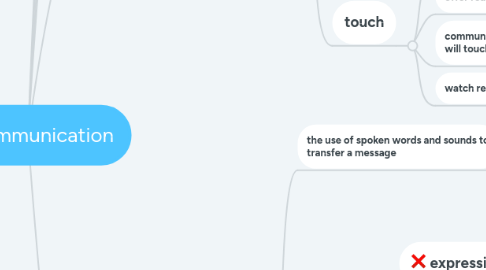
1. Sender has an idea to communicate
1.1. Sender encodes an idea in a message
1.1.1. the message travels over a channel
1.1.1.1. Reciver decodes the message
1.1.1.1.1. Reciver understands and gives feedback to sender
1.2. sender encodes an idea in a message
1.2.1. message travels over a channel
1.2.1.1. Reciever experiences noise
1.2.1.1.1. Receiver does not understand message
2. Noise
2.1. Inhibits effective communication
2.1.1. physical pain
2.1.2. mental or physical distractions
2.1.3. reciever is not interested
2.1.4. electronic channels experiencing technical difficulties
3. therapeutic- between HCP and patient/family
3.1. collect healthcare related information
3.2. provide healthcare related feedback in the form of education, information, and training
3.3. assess the patients behavior and modify it when appropriate
4. Culture
4.1. many patients will be from different cultural backgrounds so it is a major key to take these into consideration and find out as much information as respectfully as possible and make any changes needed to better assist the patient
5. Non-Verbal
5.1. 70% of communication is non-verbal
5.2. gestures
5.2.1. voluntary
5.2.1.1. gestures you make on purpose
5.2.2. Subconscious
5.2.2.1. things you7 do without thinking, also includes leakage- when true attitude is shown on accidnet
5.3. gaze
5.3.1. Monitoring
5.3.2. regulating
5.3.3. expressing
5.4. personal space
5.4.1. Intimate- 1.5 ft
5.4.2. personal- 1.5 - 4 ft
5.4.3. social- 4 - 12 ft
5.4.4. public- <12
5.5. posture
5.5.1. as a HCP you must keep good posture and be conscious of how your position as to not intimidate the patient
5.5.2. HCP must be symetrical- uncrossed legs
5.6. touch
5.6.1. ease patients
5.6.2. offer reassurance
5.6.3. communicate where, when, and how you will touch the patient
5.6.4. watch response
6. Verbal
6.1. the use of spoken words and sounds to transfer a message
6.2. tones
6.2.1. expressive tone
6.2.1.1. Spontaneous
6.2.1.2. emotional
6.2.1.3. uninhibited
6.2.1.4. used when telling jokes or confiding in friends, but is inappropriate in a healthcare setting
6.2.2. directive tone
6.2.2.1. authoritative
6.2.2.1.1. used to give orders, except leadership, or pass judgment
6.2.2.2. judgemental
6.2.2.2.1. not appropriate to use when speaking to patients that are seeking treatment
6.2.3. problem solving tone
6.2.3.1. rational
6.2.3.2. objective
6.2.3.2.1. most frequently used when taking care of a patients needs
6.2.3.3. unbiased
6.2.4. always remember to use standard English and not slang, and avoid medical jargon when talking to the patient
6.3. emphasis
6.3.1. knowing how you need to say something is as important as knowing what you need to say
6.3.2. emphasis placed on different parts in the sentence may lead to wrong interpretations
6.4. small talk
6.4.1. while there are important things that will need to be discussed, having small talk with the patient will help to put theme at ease and sooth nerves
6.5. commentary
6.5.1. commentary is a small detail but has a great impact on the patient
6.5.2. it can reduce fear and anxiety in the patient and help them to better understand the process
6.6. listening
6.6.1. talk to the patient, not at them, and make sure they are done talking before you begin
6.6.2. show attentiveness so they know you are listening and they have your respect
6.6.3. help the patient to be a good listening by talking in a way they can understand
6.7. focus on the patient
6.7.1. the HCP should show empathy and understanding without judgment
6.8. Empathy
6.8.1. empathy
6.8.1.1. feel what the patient is feeling and putting yourself in their shoes
6.8.2. sympathy
6.8.2.1. awareness of the patients feelings and to feel sadness or pity
6.8.3. DONT tell the patient "I know how you feel"
6.9. questions to the patient
6.9.1. open ended
6.9.1.1. further discuss the issues and concern
6.9.2. closed
6.9.2.1. yes or no answers
6.9.3. multiple choice
6.9.3.1. giving the patients more options and more of a choice in the management of their care

